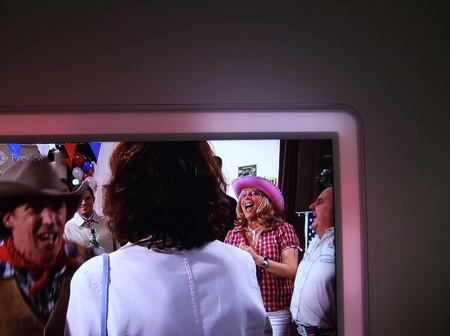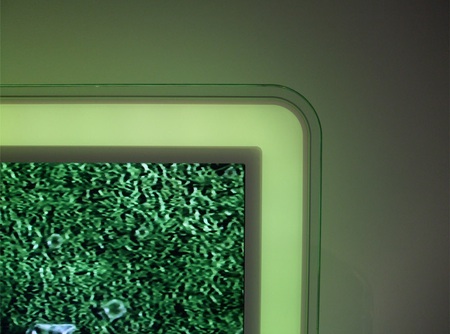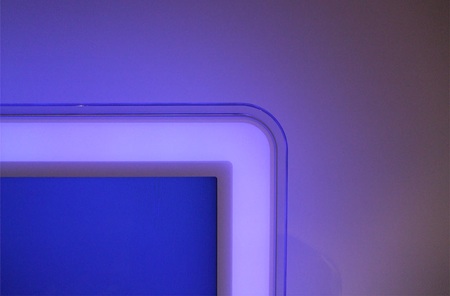Original URL: https://www.theregister.com/2008/11/15/review_lcd_tv_philips_aurea_ii_42pfl9903h/
Philips Aurea II 42PFL9903H 42in LCD TV
A stunning screen that brings truly trance-inducing experience
Posted in Personal Tech, 15th November 2008 09:02 GMT
Review How in-your-face do you want your TV to be? Why not try one with a frame that lights up? This is not just Philips' Ambilight effect, this is second-gen Aurea, where the frame sprays multiple colours at you from the front too.
So as the picture in a nature show switches from succulent leaves to a tiger’s face, so the frame snaps from variegated green to bright orange and black stripes, extending the main picture with soft-focus mimicry. And with the Ambilight matching those colours on the wall behind, Philips achieves a remarkably immersive effect.

Philips' Aurea II: a huge improvement on Aurea I
The first Aurea, released in late 2007, had a frame design so uncompromising that it divided opinion. It was curious, with the light frame curving out at you with a matte finish to the coloured lights embedded into it.
Take two is much better, with the light bezel now flat-fronted thanks to a sheet of Perspex that covers the entire front of the telly. Between the screen and the light frame is a narrow border, which on the first model was dark and noticeable, but here is much more neutral and understated. It’s a huge improvement, style-wise. The look is still going to be pretty divisive and it’s certainly worth easing yourself in gently with the frame intensity and brightness set low.
Even so, there will be people who just don’t get it. Light behind the TV is one thing, but coming out of the front too? They’ve got a point. There are times when it seems intrusive – a harrowing documentary about death and poverty doesn’t benefit from Hollywood lights flashing around the grim images, but light-entertainment shows like The X Factor and Strictly Come Dancing, look brighter, brasher and more fun when the gold lamé in the studio spills in to the frame and the wall behind.
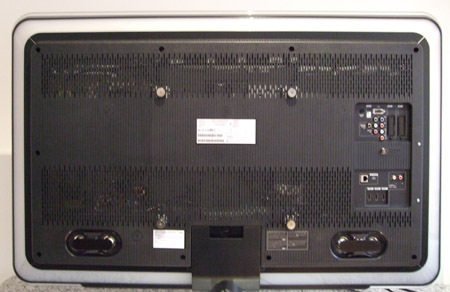
The usual connector set around the back
Moreover - and this is the clincher - watch it for an hour or so and then turn the frame and Ambilight off – there’s a dedicated button for this on the sleek remote. Suddenly, the picture looks comparatively dull and unexciting. Of course, there’s more to this TV than the light frame, but if you don’t like the effect, this isn’t the goggle box for you. Not least because, if you do use it with the light frame switched off, the whitish bezel round the picture is intrusive.
Although the Philips LCD can’t match the blacks of plasma, the light frame has another trick: by surrounding the screen with light it makes the dark greys look blacker, seeming to add to the image contrast. The rest of the design is less controversial: the curvy edges at every corner, the white glass stand and so on are more demure. There are no visible speakers - like earlier Philips screens the sound is pushed forward as though from a horn by the external clear plastic shroud round the light frame.
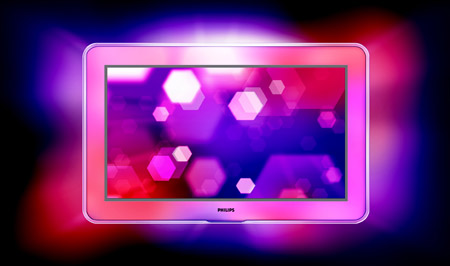
How Philips sees the Aurea projecting forth out of your TV...
It’s a discreet but effective system. Of course, there are menus to tweak the sound and picture to your preference. The remote leads you to Smart settings... but a word or two about the remote. Sleek, as we said, and oddly pleasant to the touch despite its rough underside and smooth top, thanks to buttons that are well-spaced and easy to use.
But there’s a problem: the circular ring round the OK button. You can move through menus by pressing at the four compass points or you can rotate the ring. But the ring moves in such a slippery manner that it’s nearly impossible to get it to stop where you want it to.
This was a problem on the last Philips Aurea remote and it’s no better here. Shame, as it’s otherwise a cool controller. Anyway, Smart settings offer you the simplest way of adjusting the way the screen looks. Vivid, unsurprisingly, is brighter than Standard, and you can see the frame effects beef up as you change. Energy Saving dims the frame almost completely, and if you switch to Game, it lights up again like crazy.
There are more detailed ways to fiddle with the image and sound settings, but Smart settings are maybe all you need. As a general rule, less is more. The Philips processing technologies are strong and effective, but can ruin a picture as well as improve it. Smart settings let you dabble without leaving you wondering if you should have changed the colour temperature just one bit more.
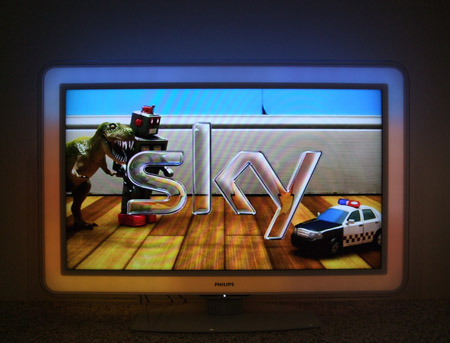
...and how it looks in reality, which is actually really rather good
The Aurea is well-connected, with three HDMI sockets at the back plus a fourth at the side for a camcorder or games machine, say. There’s a USB socket and an Ethernet jack as well as the predictable Common Interface slot component-video, composite-video and a couple of Scarts.
Also round the back of the screen are two sub-woofers. These were installed on earlier Philips screens and they lift the sound well, bouncing it off the wall behind just as the Ambilight does with the light.
Of course, the fancy lightshow would be nothing without a decent picture in the middle. Philips screens have delivered before and this one does too. The 100Hz, full HD panel has an extra-wide colour gamut, which really just means the colours are bright and there’s a bunch of them. You won’t notice this except that it’s all part of the exceptional realism of the picture, with gradations of skin tones especially convincing.
In the movie 21, in standard definition streamed on Virgin Media, pale flesh tones looked completely believable, and the depth of detail on Kevin Spacey’s face whether in bright light or shadow was remarkable.
How much picture sharpness you want is a personal choice, and Philips' can be so razor-sharp it’s as scratchy as video. Fortunately, the Movie setting seems to soften things a little. Freeview is also impressive, with colours perfectly balanced between muted and eye-catching. And HD content shines out spectacularly. For picture quality, this is one of the best screens yet: detailed and rich, making the most of whatever source you use.
Verdict
 When it’s switched off, the large white frame of the Aurea screen is intrusive and not to everyone’s taste. But when the screen and frame are working together, the resulting picture is immersive and addictive. It’s an easy TV to like, though not cheap, and with the exception of the control dial on the remote, pretty hard to fault.
When it’s switched off, the large white frame of the Aurea screen is intrusive and not to everyone’s taste. But when the screen and frame are working together, the resulting picture is immersive and addictive. It’s an easy TV to like, though not cheap, and with the exception of the control dial on the remote, pretty hard to fault.
